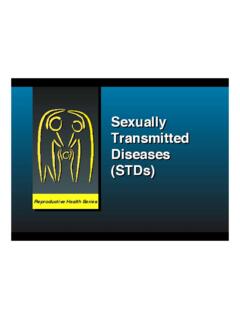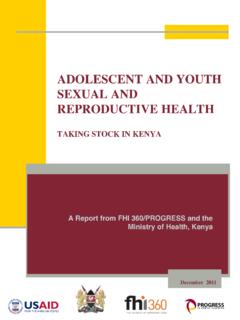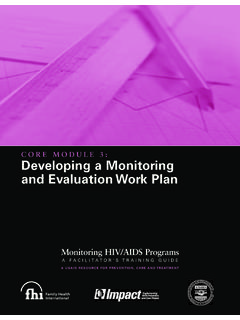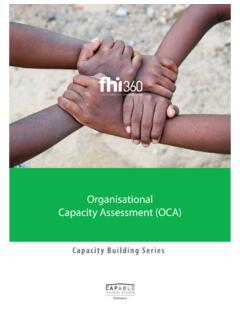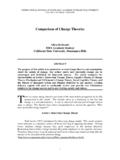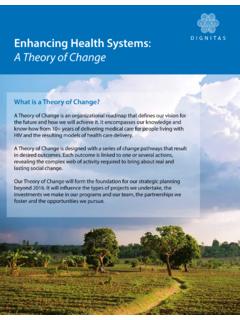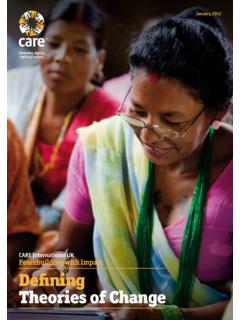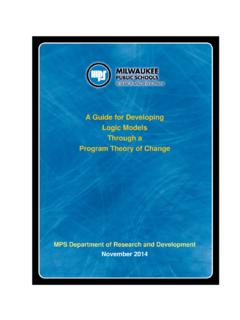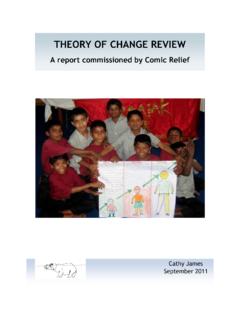Transcription of THEORY OF CHANGE - FHI 360
1 1 THEORY OF CHANGE Integrated Access to Care and Treatment 2011-2014 2 Acknowledgements This work is made possible by the generous support of the American people through the Agency for International Development (USAID). Financial assistance was provided by USAID to FHI 360 under the terms of the Preventive Technologies Agreement No. GHO A 00 09 00016-00. The contents do not necessarily reflect the views of USAID or the United States Government. 3 Table of Contents 1. Goal of I-ACT 5 2. THEORY of CHANGE Narrative 5 Assumptions informing the I-ACT TOC 5 Indicators 6 Interventions 7 Problem 8 Barriers 9 Fig.
2 1 I-ACT THEORY of CHANGE diagram 4 Fig. 2 I-ACT Implementation Model 10 4 Figure 1: I-ACT Program THEORY of CHANGE Diagram 5 1. Goal of I-ACT To promote the early recruitment, referral and retention of PLHIV into care and support programs 2. THEORY of CHANGE Narrative The project is based on the THEORY that recruitment and retention of newly diagnosed People Living with HIV (PLHIV) into care and support groups will reduce the high rate of loss to follow up between the time of diagnosis and the commencement of ART. By being a member of an I-ACT support group (closed or open), PLHIV gain important information (through the 6 sessions) that lead to positive living, increasing their likelihood of remaining in care and support, pre and post ART initiation.
3 Assumptions informing the I-ACT TOC The intended impact of the I-ACT project is to reduce loss to follow-up for PLHVI pre and post ART initiation. ,The following assumptions must be met for I-ACT impact to be achieved: PLHIV are empowered and are capable of assuming responsibility for own health needs. The following are preconditions for the empowerment of PLHIV: o Support Group Facilitators (SGFs) are empowered to facilitate and sustain support groups and impart information as prescribed by the 6 sessions in the I-ACT curriculum o PLHIV gain information from the 6 I-ACT sessions, adopt positive lifestyle and assume health-seeking attitudes o Based on the positive health-seeking attitudes, PLHIV will adhere to clinic / hospital appointments and benefit from scheduled CD4 tests and other necessary treatment ( , prophylaxis for opportunistic infections and vitamins)
4 O As a result of regular clinic visits, PLHIV will benefit from routine monitoring of their health status and will therefore be initiated timely on ART The above assumptions clarify why the I-ACT program supports PLHIVs to receive on-going care and support services and remain within the health system and be initiated timely on ART. For the Outcome: PLHIV are empowered and are capable of assuming responsibility for their own health needs the following assumptions must be met for this outcome to be achievable: An enabling environment for I-ACT implementation exists. The following are preconditions for the enabling environment for I-ACT implementation: 6 o Master Trainers, Trainer of Trainers (TOTs) and SGFs are trained.
5 It is assumed that Master Trainers will work with partners (FHI360) and SA Partners to train TOTs, who will then train Support Group Facilitators (SGFs). In turn SGFs will be established to facilitate support groups. o Facility Managers are aware of I-ACT and support the program. The assumption is that support from Facility Managers is a necessary pre-condition for the successful implementation of I-ACT, (either facility-based or community based). This will strengthen up and down referrals and the SGF reports will be signed off by the facility prior to submission to the district. If HCT counsellors and Professional Nurses are aware of I-ACT they will down refer clients who test positive to support groups.
6 O Closed and open support groups will be formed. It is assumed that support groups will be formed if there is support from Facility Managers and Professional Nurses as there will be strong up and down referrals. o PLHIV will enrol into support groups and complete the 6 I-ACT sessions. It is assumed that I-ACT support groups will empower PLHIV with knowledge and skills, including to come to terms with the diagnosis and explore healthcare management strategies The above assumptions make explicit how an enabling environment for the implementation of I-ACT will result in the establishment and sustainability of support groups, which will in turn result in empowerment of PLHIV in taking charge of their own health needs.
7 Indicators Impact: Reduced loss to follow-up of Pre-ART PLHIV % pre-ART PLHIV who have completed the 6 I-ACT sessions and visited a health facility in the past 6 months Outcome 1: Number of SGFs empowered to facilitate support groups and impart knowledge % active SGFs Number of HIV+ individuals registered in closed/ open support groups % I-ACT support group members who complete 6 I-ACT closed group sessions Outcome 2: PLHIV informed about HIV/AIDS, live positively % I-ACT support group members who have complete the 6 sessions who report having disclosed their HIV status beyond a trusted few individuals % I-ACT support group members who have completed the 6 sessions who report having used a condom in their last sexual encounter 7 % I-ACT support group members who have completed the 6 sessions who report having reduced alcohol/drug consumption Outcome 3.
8 Pre-ART PLHIV adhere to clinic appointments % I-ACT support group members who have completed the 6 sessions who are eligible for prophylactic treatment who are currently taking their treatment Outcome 4: PLHIV initiated timely on ART % of PLHIV initiated on ART within/ above the threshold Output: Number of TOTs trained Number of SGFs trained Number of SGs formed Number of PLHIV enrolled and completing all sessions Number of facility managers, HCT, Counsellors, PN informed Interventions The following interventions explain what the I-ACT program must do in order to achieve the desired outcome and impact.
9 Road shows to build political and civil society support for I-ACT: Road shows will create awareness on I-ACT at different levels local leaders and traditional leaders as well as district leadership in the Department of Health and the Department of Social Development (DSD). It is assumed that this awareness will result in support for the I-ACT program, provision of venue, printing facilities, soup kitchens (DSD). Identify and train Master Trainers, TOTs and SGFs: Training TOTs will contribute to the success of the program as they will help cascade I-ACT training for SGFs. Competent SGFs will establish and sustain support groups.
10 Provide I-ACT orientation to Facility Managers, Professional Nurses and HCT counsellors: Buy-in and support of I-ACT by facility managers is key to the success of the program as each support group has to be linked to a healthcare facility, regardless of whether it is facility-based or community-based. Apart from referring prospective support group members, health facilities also sign off the reports from the SGFs before submission to the district. Support of Professional Nurses and HCT counsellors is also important and these provide a link between clients who is tested HIV positive and an SGF who facilitates a support group.


